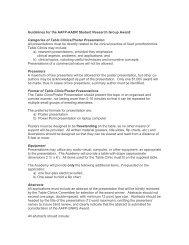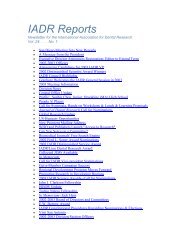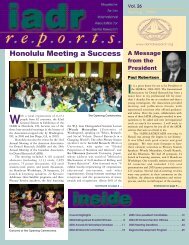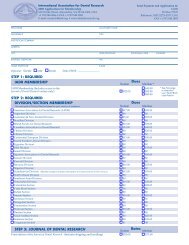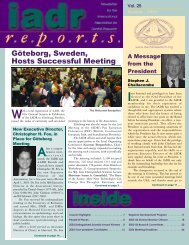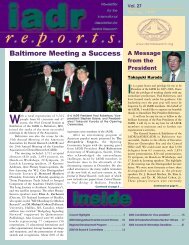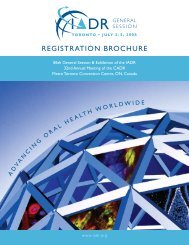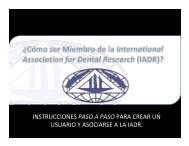2012 AADR/CADR CALL FOR ABSTRACTS - IADR/AADR
2012 AADR/CADR CALL FOR ABSTRACTS - IADR/AADR
2012 AADR/CADR CALL FOR ABSTRACTS - IADR/AADR
Create successful ePaper yourself
Turn your PDF publications into a flip-book with our unique Google optimized e-Paper software.
4. Agree to pre-register for the meeting and pay the appropriate registration fee by the presenter pre-registration deadline of January 18, <strong>2012</strong>.Failure to pre-register by January 18, <strong>2012</strong> will result in the following:• The abstract will be automatically withdrawn from the Program Book and the Online Abstract System.• Submitter will not be allowed to present his/her abstract at the meeting.• The abstract will not be citable as being part of the Special Issue of the Journal of Dental Research.<strong>IADR</strong>/<strong>AADR</strong> Abstract Licensing PolicyBy submitting an abstract to the <strong>IADR</strong>/<strong>AADR</strong>, and in consideration for the opportunity to be included in the <strong>IADR</strong>’s/<strong>AADR</strong>’s presentations, the author of theabstract hereby provides to the <strong>IADR</strong>/<strong>AADR</strong> a non-exclusive, irrevocable, worldwide, royalty-free license to use the abstract in the <strong>IADR</strong>’s/<strong>AADR</strong>’spublications and materials. To the extent that the <strong>IADR</strong>/<strong>AADR</strong> incorporates an abstract in a collection or compilation of materials, including but not limited toany publication of meeting abstracts or an online, searchable collection of abstracts, the author acknowledges and agrees that the <strong>IADR</strong>/<strong>AADR</strong> shall own allright, title and interest in and to such collections and compilations including any copyrights to said collections and compilations. Notwithstanding the foregoing,U.S. Government Works, as defined under the Copyright Act found under Title 17 of the U.S. Code, are exempt from any copyright transfer contemplatedherein, and any purported transfer of the copyright to a U.S. Government Work pursuant to this subsection shall be of no force or effect.<strong>IADR</strong>/<strong>AADR</strong> Full Disclosure PolicyThe <strong>IADR</strong>/<strong>AADR</strong> seeks to provide participants in its education sessions with current, scientifically-based information relevant to dental, oral, and craniofacialresearch, the practice of dentistry, and the oral health of the public. Once a presenter is selected for a particular topic, the <strong>IADR</strong>/<strong>AADR</strong> makes no attempt tocontrol the content of the presentation or the content of any submitted abstract. Therefore, in submitting an abstract for presentation and publication, apresenter represents and warrants to the <strong>IADR</strong>/<strong>AADR</strong> that any intellectual property associated with or contained in the content of the abstract orpresentation is owned by the presenter or the presenter is authorized to use said content along with any applicable intellectual property associated with thecontent.A presenter may be required by the <strong>IADR</strong>/<strong>AADR</strong> to provide adequate written assurance that the presenter is authorized to use the content of the abstract orpresentation. In the event the <strong>IADR</strong>/<strong>AADR</strong> requests such written assurance and the presenter fails to provide the requested documentation, the presentermay be denied the ability to make the presentation. For any abstract or presentation, the presenter and any applicable co-authors of the content must beidentified by full name and any affiliation. The presenter also has received the approval from the co-author(s) to have their name(s) associated with the abstractand its content prior to submission.The presenter further agrees to indemnify and hold harmless the <strong>IADR</strong>/<strong>AADR</strong> from any and all claims of third parties regarding the content of the abstract orpresentation, including but not limited to any claims of infringement of intellectual property or misappropriation of proprietary or trade secret information.In order to ensure fairness to the audience and the public, however, the <strong>IADR</strong>/<strong>AADR</strong> requires each presenter to disclose:1. Any financial relationship between the presenter andAmerican Association for Dental Research – <strong>2012</strong> Call for Abstracts Page 2
a. A company that manufactures or distributes a product discussed in the presentation, orb. A company whose product competes, or may compete, with a product discussed in the presentation must be disclosed to the <strong>IADR</strong>/<strong>AADR</strong>upon approval on the abstract form and must be disclosed to the audience at the beginning of the presentation.As used in this document, "financial relationship" includes a consulting arrangement or the conduct or research for the company by the presenter or amember of the presenter's immediate family. It also includes ownership of stock or other interest in a company by the presenter, and/or a trust of whichthe presenter or a member of the presenter's immediate family is a beneficiary, to the best knowledge of the presenter.2. All presentations must be made in a professional manner, without disparaging colleagues, companies, or products. Unnecessarily demeaning commentsand attacks on colleagues, companies, or products are unacceptable.Failure to adhere to these guidelines may result in sanctions as deemed appropriate by the <strong>IADR</strong>/<strong>AADR</strong>, including denial of permission to present at future<strong>IADR</strong>/<strong>AADR</strong> meetings.Presenter ChangesIf you are unable to attend the meeting and wish to name a substitute presenter, please use the following guidelines:• Substitute presenter must be a co-author.• Substitute presenter must NOT be presenting another abstract at the meeting.• After the abstract replacement deadline of October 10, 2011 all requests for presenter changes MUST be made using the Presenter Change/WithdrawForm (link to be made available after the abstract deadline). Requests made using this form will be processed.• Substitution requests must be made PRIOR to the meeting.• Failure to follow the above procedures may result in the presenter being charged the full registration fee and/or not being allowed to present at afuture meeting.Withdrawal of AbstractsThe following are the guidelines for withdrawing abstracts:• You may withdraw your abstract at any time until October 3, 2011, without notifying <strong>AADR</strong>.• Abstracts withdrawn after October 3, 2010, must be withdrawn using the Presenter Change/Withdraw Form. Requests not submitted via this formwill not be considered.• Withdrawal requests must be received PRIOR to the start of the meeting.• Lack of travel funds is NOT an acceptable excuse for withdrawing an abstract from the meeting.• Failure to follow the above procedures may result in the presenter being charged the full registration fee and/or not being allowed to present at afuture meeting.PLEASE NOTE: Any submitted abstract that does not contain actual text will be withdrawn automatically after October 10, 2011.American Association for Dental Research – <strong>2012</strong> Call for Abstracts Page 3
Replacement AbstractsThe following are the guidelines for replacement abstracts:• You can make as many changes to the abstract content, title, and/or list of authors prior to the abstract submission deadline date October 3, 2011 at nocharge.• After the submission deadline date, you will be required to pay a $65 fee for each replacement abstract processed prior to midnight PST October 10,2011. The fee must be paid before gaining access to your abstract.• Follow online instructions to revise your abstract as needed.• Please note that you will be required to pay the $65 fee every time you access your abstract after the submission deadline date of October 3, 2011.• Any submitted abstract that does not contain actual text will be withdrawn automatically on October 11, 2011.No changes to abstract text including typos, incorrect data, etc. will be permitted after October 10, 2011.PREPARING TO SUBMIT AN ABSTRACTAll abstracts must be submitted online via the <strong>AADR</strong> online abstract system (no paper submissions will be accepted). Each completed submission is peerreviewedfor its scientific content by Scientific Group/Network Abstract Reviewers and Group Program Chairs.Important Submission Elements1. Scientific Group/Network: All abstracts must be submitted to an appropriate Scientific Group/Network for review based on the scientific content ofthe abstract. A large majority of abstracts are transferred each year. If you select the appropriate area, you are more likely to be graded by peers withsimilar interests and who are familiar with you and your research topic. See page 8 for a complete listing.2. Titles: Abstract titles are limited to 10 words or less (so make the title dynamic and conclusive, rather than descriptive) and should be entered in titlecase (AP Style) format. In general, you should capitalize the first letter of each word unless it is a preposition or article. Do italicize scientific names oforganisms such as streptococci or candida.3. Authors: Each author should be added separately to the submission. Enter first (given) name, and last (family/surname) name for each author plusinstitution/affiliation. Please do not list the department/branch in the institution/affiliation field. One person must be identified as the presenting author.The order of the authors can be modified at any time prior to the abstract deadline. Note: In general, <strong>AADR</strong> will not list each author’s department inthe Program Book due to space limitations.4. Abstract Text: All abstracts should be 300 words or less. When composing your text, be sure to use a word processor in order to save your abstractin advance. You should not write your abstract into the online form in case for any reason your internet connection is lost. You will be able to uploadyour file during the submission process; you should also be prepared to use HTML coding as needed. Do not include your title or authors in the abstracttext–-these items will be collected separately. Do not include references. If the abstract is based on research that was funded entirely or partially by anoutside source, then be sure to enter the appropriate information (funding agency and grant number if applicable) at the title step. You do not need tore-enter the information with your abstract text. However, all external funding MUST ALSO BE included in the presentation (if accepted). Tables areAmerican Association for Dental Research – <strong>2012</strong> Call for Abstracts Page 4
permitted but should be simple and concise. Graphics are not recommended unless they are integral to the abstract and should be limited to no morethan 1 or 2.Content of the Abstract: Titles, authors and authors' affiliations are not included in the 300 word limit (references are not collected by <strong>AADR</strong>).The abstract must contain a brief statement of:a. The objectives of the investigation,b. Experimental methods used,c. Essential results, including data and, where appropriate, statistics,d. ConclusionTo achieve a more consistent style, the words: "Objectives:", "Methods:", "Results:", and "Conclusion:", each immediately followed by acolon as shown, must appear in the body of your abstract. The online abstract system will not accept abstracts unless they contain theseaforementioned words.5. Other Items: the following information should be submitted:• Keywords: All abstract submissions may select up to 5 keywords from a list (one keyword entry may be typed if not found in the predefinedlist).• Themes (optional): New this year, <strong>AADR</strong> will ask if your research fits well into one of the themes created by the Annual SessionCommittee. If you make a selection, it may be used by the Group Program Chairs and/or the Annual Session Committee as an additionalfilter to create cohesive, thematic sessions. The <strong>2012</strong> <strong>AADR</strong> themes are listed below:Basic Science ThemesThe Oral Microbiome: Implications for Models of Oral DiseasesOral Cancer: microRNAs and their Value as Predictors of Disease ProgressionStem Cell Biology in Craniofacial TissuesScaffolds for Use in Regenerative Dental MedicineGene-environment Interactions and Epigenetics in Oral DiseasesEmerging Approaches for Bioinformatics Analyses for Genetic DataResearch, Education, and Clinical Practice ThemesDefining Translational Research for DentistryOral Health Challenges in the Aging PopulationTransitioning Research Findings to Dental CurriculaResearch Issues around Prescription Drug Abuse and Over Prescribing of OpiodsIssues in Research Training: How to Prepare the Most Competitive Scientists• Awards/Competitions (optional): Please be sure to select any applicable awards or competitions during the abstract submissionprocess.American Association for Dental Research – <strong>2012</strong> Call for Abstracts Page 5
• Contact Information: <strong>AADR</strong> will only correspond with the presenting author listed on the abstract regardless of who mayhave submitted the abstract. Thus, make sure to include a correct e-mail address/phone number for the presenting author. If thepresenting author relocates before the <strong>2012</strong> <strong>AADR</strong> Annual Meeting, please be sure to notify the <strong>IADR</strong>/<strong>AADR</strong> Meetings Department withthe new information. The abstract submission system is not connected to the member database, so any membership updates will not bereflected in the abstract submission system. Please make every attempt to enter the correct membership number for the presenter if he/sheis a member of <strong>IADR</strong> or <strong>AADR</strong>.• Chair Opportunities: Be prepared to enter whether or not the presenter is interested in serving as an Oral/Poster Discussion Chairand/or Poster Chair.English Language Assistance Program (ELAP)<strong>IADR</strong>/<strong>AADR</strong> is pleased to introduce a new program called the English Language Assistance Program (ELAP) to assist our abstracts submitters with EnglishLanguage, through the generous support of our <strong>IADR</strong>/<strong>AADR</strong> colleagues who have agreed to volunteer. This program is designed to assist non-native Englishspeaking abstracts submitters during the abstracts submission process.Individuals who are interested in applying for the ELAP need to complete the online form by August 31, 2011. Individuals will be matched with our volunteersbased on their expertise, geographic location and availability.Once the match has been conducted, both the individual and the volunteer will be notified. It is the abstract submitter’s responsibility to contact the volunteerand submit his/her abstract for the language review. Please note that this program is by no means a review of the scientific content of the abstractor a guarantee of acceptance for presentation. Volunteers will only review the abstract for the language content and will propose necessary suggestionsfor the corrections to ensure that the submission has used proper English language.Once program volunteers have communicated with the submitter about the document and the suggested corrections have been made, it is the submitter’sresponsibility to submit the revised abstract to <strong>IADR</strong>/<strong>AADR</strong> by the proposed deadline for consideration for presentation. Abstracts can be submitted online atwww.aadronline.org/aaam.Please note that individuals in the ELAP are required to submit their abstracts twice – once to the program for editing and matching with a volunteer, and againto the <strong>AADR</strong> abstract submission site after English language editing has been completed.To ensure that the submitter and volunteer communicate in a timely manner, <strong>IADR</strong>/<strong>AADR</strong> will follow up with both individuals. Any problems with a volunteermatch can be communicated to <strong>IADR</strong> at ELAP@iadr.org.We hope that this program will encourage individuals to submit abstracts for <strong>AADR</strong> meeting by facilitating the improvement of English language skills within theresearch community.Please contact <strong>IADR</strong>/<strong>AADR</strong> at ELAP@iadr.org if you have any further questions about this program.American Association for Dental Research – <strong>2012</strong> Call for Abstracts Page 6
Systematic Review Abstracts<strong>AADR</strong> will accept Systematic Review Abstracts. Systematic Reviews are defined as, “a review of a clearly formulated question that uses systematic and explicitmethods to identify, select and critically appraise relevant research, and to collect and analyze data from the studies that are included in the review. Statisticalmethods (meta-analysis) may or may not be used to analyze and summarize the results of the included studies. The aim is to ensure a review process that iscomprehensive and unbiased. Findings from systematic reviews may be used to determine research priorities and/or provide the scientific basis for clinicaltreatment.”Common Mistakes• Failure to state objective and conclusion.• Failure to state sample size and data.• Excessive use of abbreviations.• Excessive use of commercial product names.• Typographical errors (remember that you can’t change any of your text after the replacement abstract period).• Writing your abstract at the last minute (this increases stress and leads to errors).• Work that is duplicative is not well received and you will only be asked to combine with another abstract or your abstract may not be accepted.Make sure to show your abstract to a colleague prior to submission to avoid making common mistakes.Group-author AbstractsSome research collaborations with large numbers of investigators, operating under a single group name, request the inclusion of the group name as an author,distinct from the individual authors. Group authors may also be known as Collaborative-, Corporate- or Collective-authors. Group-authors would includeindividuals who contributed to the research that led to the abstract but are not named individually as authors. A common example in dental research would bea practice-based research network. Group-authorship is not meant to acknowledge the University, Institution or Corporation under whose auspices theresearch was conducted. If your abstract does have a Group-author that includes individuals who contributed to the research that led to the abstract but arenot named individually as authors, the name of the Group-author must be added along with the City, State/Prov. and Country. The Group-author listings willbe included in the Author/Co-author Index online, the Program Book and the USB of Abstracts.Word Limit Help• Always hyphenate when possible (e.g., use “composite-resin restorations”, rather than “composite resin restorations”), and string together complicatedphrases with hyphens.• Abbreviate extensively [i.e., introduce abbreviations quickly and use them. Do not say hybrid zone but rather introduce hybrid zone (HZ) and then useHZ from that point onward].• Always close spaces between numbers and units (e.g., instead of 30 mm, say 30-mm or 30mm; never leave spaces between numbers & standarddeviations; and replace “30 ± 5” with “30±5”).• Always use tables for the presentation of information when possible. Put units in headers and omit them from the rest of the matrix.American Association for Dental Research – <strong>2012</strong> Call for Abstracts Page 7
• Make sure that there is no inadvertent ‘dangling punctuation’ in the text, such as a comma or period that is not immediately adjacent to a word.• Eliminate as many “articles” (a, an, the, …) as possible.• String together all of the steps in the Materials & Methods section so that you are not starting and stopping individual sentences with separate subjects,verbs, and adjectives [e.g., “The samples (n=10/gp) were etched (37% H3POO4), washed (15s), stored (37°C, 7d), conditioned (25°C, 10m), tested(0.1mm/m), and statistically analyzed (ANOVA, Tukey’s, p
Reasons for rejection are:1. Abstract is not original research.2. The research is not innovative in its approach to the stated problem (methodology or data collection or analysis or data interpretation).3. Nature of problem not explicit from either title or abstract.4. Material too closely related to another abstract submitted by the same co-authors; should have been combined into a single paper.5. Abstract has been presented at other meeting(s) or previously published.6. Abstract poorly organized and/or not complete. Required information not given in abstract:1. Objective2. Methods3. Results – data and statistical analysis, or4. Conclusions7. Methods of obtaining data not appropriate with respect to the stated problem for the following reasons:1. Methods not sufficiently precise to permit the measurements to be accurate, i.e., variations are within the error limits for the method.2. Sampling method contains inherent discriminatory factors not recognized.3. Size of sample insufficient to show significant conformity or differences.4. No well-defined criteria given for evaluation of variables.5. Choice of controls questionable.6. No control groups reported.8. Significance of results related to the nature of the problem being studied is not stated.9. Conclusions do not necessarily follow as a consequence of the method of analysis applied to the data.10. Conclusions not adequately qualified, i.e., conclusions have greater limitations than implied by the author.11. Correlations suggested may be fortuitous insofar as no plausible cause-and-effect relation has been suggested, and none is obvious.12. Abstract is not in English.SUBMISSION CATEGORES BY SCIENTIFIC GROUP/NETWORKBehavioral, Epidemiologic and Health Services Research: Check the box for abstracts regarding behavioral studies and other studies involving pain andanxiety, utilization of dental services, professional education, provision of care, clinical decision analysis, cost-effectiveness analysis, comparative-effectivenessresearch, reimbursement mechanisms or delivery systems and their effect on oral health. Studies that address the following topics are also appropriate:anthropology, psychology, sociology, health education and promotion, economics, finance and public health. Check the “epidemiological methods” box forpapers that include important and timely issues pertaining to the design and conduct of human research studies. Descriptive epidemiology papers should besubmitted to the Group corresponding to the topic area of the abstract.Cariology Research: Papers should be related to dental caries–specifically, its etiology, prevention, diagnosis and treatment. Research approaches couldinclude: epidemiology, clinical studies, or laboratory and animal experimentation. Studies that are concerned with caries, but where the major emphasis isrelated to microbiology, salivary glands, or dental materials, should be considered by those particular Groups. The following submission options will beavailable: Demin/Remineralization; Erosion; Fluoride and Ca-based Products; Detection; Risk Assessment and Others; Microbiological Studies/Biofilm; andClinical and Epidemiological Studies.American Association for Dental Research – <strong>2012</strong> Call for Abstracts Page 9
Craniofacial Biology: This area covers a broad array of basic science and clinical studies dealing with the normal growth, development, and maintenance ofthe craniofacial tissues and the consequences of physiological and pathological variations and challenges on these processes. Please submit papers for thecraniofacial biology program based on the following division of topics: (I) Molecular—molecular aspects of craniofacial genetics, development, and cellbiology; or (II) Other studies—including teratology, oral physiology, population studies, orthodontics, oral biology and temporomandibular joint function.Dental Anesthesiology Research: Abstracts submitted in the dental anesthesiology category should relate to clinical and basic research in the methods andtechniques for anxiety relief and pain control. These scientific areas of concentration may include local anesthesia, analgesia, sedation and general anesthesiafor the systemic management of dental patients, especially medically compromised patients, and should also include the necessary precautions for thetreatment of medical emergency cases.Dental Materials: All scientific aspects of dental materials are appropriate for this category. This includes laboratory, clinical, and animal testing of materialsand their components, as well as instruments and equipment. The interactions of materials and the oral environment are also included. The development ofnew materials, testing methods, and protocols is of particular interest. Please submit papers for the dental materials program based on the following division oftopics: I) Adhesion-Bond Strength Testing and Mechanisms: Shear and tensile bond strength testing of glass-ionomers, and bonding resins utilized inbonding resin composite to enamel/dentin, and alternative bond strength tests. II) Adhesion-Leakage/Margin Assessments: Pit and fissure sealants, glassionomers,resin bonding of ceramics, fibers and metals, adhesive microstructure analysis, adhesive surface analysis, assessment of margin quality andmicroleakage of all materials. III) Ceramic-based Materials and Cements: Ceramics (except resin bonding), cements, sintered ceramics, machinedceramics, ceramo-metal systems, conventional and light-cured glass-ionomer cements, and surface characteristics. IV) Clinical Trials: Human studies for allmaterials. V) Biocompatibility and Biologic Effects: Biocompatibility tests, antibacterial /anticariogenic materials and therapy, bio-active materials,regenerative therapy, interactions with oral environment and tissues. VI) Polymer-based Materials-Chemistry and Composition: New monomersystems and chemical modifications of polymers, composites, prosthetic resins and elastomers. VII) Polymer-based Materials-Physical Properties andPerformance: Mechanical and physical properties (not related to chemistry or adhesion), wear, surface characteristics and solubility of polymers, composites,prosthetic resins and elastomers. VIII) Metal-based Materials: Amalgam, mercury, cast alloys, shape memory alloys, wrought wires, metallic implantmaterials. IX) Other Materials - Chemistry, Properties, Performance: Remineralization agents, orthodontic, endodontic, operative, gypsum,impression, investment materials. X) Instruments and Equipment: Curing light units, cutting, finishing and polishing instruments, endodontic posts, andtheir mechanical properties, safety and efficacy, new microscopic and analytical techniques, CAD/CAM equipment. XI) Color and Appearance (Esthetics):Optical properties of all dental materials (color, translucency, gloss, fluorescence, opalescence, surface texture), in-vivo and in-vitro tooth whitening, instrumentsand equipment.Diagnostic Sciences: This subject area is concerned with the detection and measurement of the severity and progression of all oral diseases. Equipment andtechniques include, but are not limited to, methods such as radiography, optical, sound, nuclear medicine and magnetic resonance imaging. The subject areaalso includes evaluation of the accuracy and reproducibility of diagnostic methods as well as studies in clinical decision-making.Education Research: Submissions are invited relating to research affecting all facets of education in the field of dentistry and oral health. Areas include butare not limited to: educational practice; teaching and learning dynamics; teaching evaluation, curriculum design, program evaluation, and outcomes evaluation atall levels (professional and public); competency evaluation (validity and reliability); applications of new technologies, methodologies, teaching and researchapproaches, characteristics of institutions, educators, and students, licensing and certification, quality assurance, continuing competence, and professionalAmerican Association for Dental Research – <strong>2012</strong> Call for Abstracts Page 10
development, as well as cross-professional interaction.Geriatric Oral Research: This subject area deals with research in the basic mechanisms of aging, the prevalence and characteristics of diseases anddisorders in the aged, and their prevention and treatment. This includes general biomedical research, oral medicine, patient management, clinical techniques,and delivery systems, as well as the psycho-social and economic aspects of treating the older adult.Evidence-based Dentistry Network: This EBD Network will consider abstracts that relate to all the aspects in the development and practice of evidencebasedDentistry. Submissions will be reviewed for validity, importance, and application of methods and techniques for developing, teaching and implementingknowledge distillation and transfer.Implantology Research: This subject area is concerned with the basic and clinical science aspects of the implantation of materials and/or biologicalanalogues into the orofacial complex for the augmentation, replacement, or regeneration of body tissues, excluding tooth restoration. The properties of boththe natural tissues being replaced and the synthetic/biological substitutes are of interest. The subject area includes: structural and property studies on naturaland synthetic materials, biological investigation, tissue/material interfaces, and systematic clinical evaluation of implant materials and designs.Microbiology/Immunology: The microbiology/immunology subject areas include the following: micro-organisms, such as bacteria, viruses, fungi, protozoa,etc., and their relationship to and/or association with oral diseases; microbial pathogenesis; microbial biofilms; microbial genetics, gene structure, geneexpression and regulation, genomics, and proteomics; microbial physiology and the by-products of micro-organisms and their relationship to oral diseases; theeffects of chemicals, antimicrobial agents, etc., on the physiology and virulence of oral micro-organisms; the serologic and immunologic aspects of oral diseases(human immunologic response to oral micro-organisms); the systemic effects of oral organisms; oral manifestations of systemic diseases; and cell biology andtissue culture studies (excluding experimental pathology) as they relate to oral micro-organisms and diseases. Infection Control: This area includes researchcovering all aspects of infectious disease transmission and control in the context of oral health care and its delivery in any setting, including the dental office,laboratory, and hospital. Presentations may include assessments of transmission potential and risk, methods of disease spread, or techniques for prevention ofcross-infection arising from any source, such as person-to-person contact or via fomites or aerosols.Mineralized Tissue: This subject area is concerned with research principally directed toward elucidation of some aspects of hard-tissue structure,formations, or function. While overlap between research in this area and that of cariology, periodontology, and/or salivary research may frequently occur,distinction should be made on the basis of the primary goal of the research. The following session topics should aid you in determining whether a researchtopic is appropriate for this area: formation of calcium phosphates; regulation of mineralization and dissolution; fluoride; development and mineralization;matrix constituents; regulatory factors in bone resorption; regulatory factors in cell culture; ultrastructure and morphology; and morphology, physiology, andchemistry.Network for Practice-based Research: This subject area will consider abstracts that relate to any research performed in dental practice, away fromuniversities or laboratories. This may include research on any topic performed in private, public, military or other dental clinics. It may be on topics such as theevaluation of materials, equipment or techniques both clinical and non-clinical, the evaluation of administrative and financial aspects of practice, social,epidemiologic and behavioral evaluation relevant to dental practices and many others.American Association for Dental Research – <strong>2012</strong> Call for Abstracts Page 11
Neuroscience: Neuroscience is concerned with the role of the nervous system in orofacial function and in clinical problems associated with orofacialsensory, neuromuscular, and articular disorders. More specifically, basic science research interests include studies of the structure and function of the nervoussystem and the neural basis of behavior. These involve investigations of neural regulation of development and neural plasticity, excitable membranes, synaptictransmission, neurotransmitters, receptors, neuro-endocrine, exocrine, autonomic regulation, sensory systems (especially pain), muscle and motor systems,and sensorimotor integration. The clinical interests of this subject area include clinical studies of orofacial sensation, such as pain, temperature, touch, taste,studies on jaw, facial, and oral reflexes, as well as more complex sensorimotor functions such as voluntary movement, mastication, swallowing, and speech. Inaddition, movement control and movement disorders such as orofacial dyskinesia or Parkinson’s, and sleep-related orofacial disorders such as bruxism andapnea-snoring are relevant. Neuroscience/TMJ is also particularly concerned with all aspects regarding the measurement, mechanisms, diagnosis, and treatmentof orofacial and TMJ pain and neuromuscular dysfunction.Nutrition: The oral cavity is the site of many acute and chronic diseases and congenital anomalies, any or all of which may be linked to nutritional status. Thepurpose of the Nutrition Group is to bring together dental scientists who are interested in sharing and exploring new avenues of research in the area ofnutrition and oral/craniofacial health and, conversely, the consequences of oral/craniofacial dysfunction on general nutrition and health.Oral Health Research: The area covers a broad array of basic, clinical, and applied studies related to: oral/dental hygiene strategies for the prevention oforal disease and the promotion of wellness; the outcomes of primary and secondary preventive care provided to and in collaboration with individuals andgroups in a variety of settings; interdisciplinary approaches to integrating oral health into general health; clinical efficacy of professional and personal oralhygiene measures; methods to improve health outcomes of compromised patients through improved oral hygiene; the dental hygiene process of care; self-carestrategies, including adaptations for special and culturally diverse populations, client-coping and practitioner caring dimensions, and promotion of healthfullifestyles; disease-prevention-/health-promotion-focused curricular models; science transfer methods; ethics and quality assurance; alternative patterns ofpractice; clinical decision-making; and issues related to the conduct of research, including approaches to subject recruitment and retention, protocolcompliance, data management and monitoring, quality control, and study coordination.Oral & Maxillofacial Surgery: Abstracts submitted in the oral & maxillofacial surgery category should relate to basic and applied research dealing with thesurgical and non-surgical management of: impacted teeth; residual ridge deformities and their reconstruction with grafts, alloplasts, and implants; dentofacialand craniofacial deformities; temporomandibular joint dysfunction; hard- and soft-tissue trauma; benign and malignant diseases of the soft and hard tissues,including salivary glands; reconstruction of soft- and hard-tissue defects; infection of the face, head, and neck; nerve dysfunction; post-surgical pain and swelling;and wound healing and factors which affect it, as well as long-term follow-up data on research done in any of these areas.Oral Medicine & Pathology: This subject is concerned with experimental investigation of diseases affecting the oral cavity and the adjacent tissues, butexcluding those (e.g., periodontal disease, caries, salivary research) more appropriately dealt with by other Groups. Experimental investigations of normalstructure are appropriate insofar as they contribute to our understanding of disease, and cell, tissue, and organ cultures are also included in this category.Epidemiological, clinical, and laboratory research is encouraged.Periodontal Research: Subjects included in this category are: epidemiology of periodontal diseases, clinical trials to evaluate treatment of periodontaldiseases, diagnosis of periodontal diseases and monitoring of disease activity, etiological factors/microbiology, pathogenesis of gingivitis and periodontaldiseases, chemoprevention and chemotherapeutic approaches, host-defense mechanisms, and gingival and periodontal tissues.American Association for Dental Research – <strong>2012</strong> Call for Abstracts Page 12
Pharmacology, Therapeutics, & Toxicology: Abstracts dealing with laboratory, clinical, public health, or epidemiologic research on the mechanism,nature, or treatment of diseases or disorders related to dentistry and the introduction of new drugs for the treatment of such entities may be submitted toPTT. Those dealing with the adverse effects of procedures, materials, drugs, devices, etc., used in the diagnosis, management, or treatment of such diseases ordisorders are similarly appropriate. Toxicological studies of drugs, chemicals, and other agents pertinent to the field of dentistry, as well as the associatedhazards of such agents, may also be included.Prosthodontics Research: The subject area of interest in prosthodontics research is rather broad and includes the following: fixed prosthodontics,removable prosthodontics, materials as they relate to prosthodontics in general, occlusion, TMJ research, implants, electromyography, basic and clinicalapplications to restorative dentistry in general, electrosurgery, ceramics, and acid-etch restorative dentistry.Pulp Biology & Regeneration Research: This research is defined as: studies on the development, structure, and function of the dental pulp, the dentinpulpcomplex, and related periapical tissues. Studies may include methods in the following areas of analysis: autoradiography, radiography, molecular biology,and protein chemistry (genomics and proteomics), microbiology, immunology, physiology, biochemistry, and pharmacotherapeutics. Physiological andpathological processes involving these tissues include: signaling mechanisms in tooth development, dentinogenesis and dentin matrix proteins, wound healingand regeneration, as well as neural, vascular, and cellular responses to anesthesia, pain-producing stimuli, materials and instrumentation used in the restorationof teeth, and hereditary diseases. Also included are those related areas of clinical research pertaining to dentin and pulpal tissues from disciplines such asendodontics, pediatric dentistry, restorative dentistry (e.g., pulpal compatibility testing of dental restorative materials), periodontics (e.g., root dentinhypersensitivity), and oral and maxillofacial surgery.Salivary Research: This subject area encompasses: the morphology, biochemistry, physiology, endocrinology, development, and pathology of salivary glands;the composition, secretion, and functions of saliva; and the synthesis of salivary components. It may also include the effects of saliva on oral structures andmicro-organisms—especially dental plaque and calculus—and the influence of such effects on oral pathological conditions—such as dental caries, periodontitis,mucositis, and ulcers—provided there is sufficient emphasis on the salivary factors.NOTIFICATIONS OF ACCEPTANCE/NON-ACCEPTANCEThe official notifications will be e-mailed on or about December 12, 2011, to all accepted presenters. The notifications will include presentation modeassignment (oral, poster or poster discussion), date, and session time. An e-mail containing your Final Presentation # will be sent after the Presenter Preregistrationdeadline (late January <strong>2012</strong>), to all registered, accepted presenters.PLEASE NOTE: All communication between <strong>AADR</strong> and the presenter will take place via e-mail. The e-mail address used will be the oneyou supply when submitting your abstract (listed under the presenter’s name). Please make sure that you use a valid, long-term e-mailaddress so that you will receive all important notices that are sent from <strong>AADR</strong> regarding your abstract and presentation at the meeting.After December 12, 2011, the placement or rejection of your abstract cannot be changed and is considered final. Please do not call <strong>AADR</strong> regarding the statusof your abstract prior to December 12, 2011. After December 12, you can also download your abstract notification letter by visiting the <strong>AADR</strong> Meeting Website (www.aadronline.org/aaam) or you can e-mail <strong>AADR</strong> if you did not receive your notification (e-mail meetings@aadronline.org or fax: +1.703.548.1883).American Association for Dental Research – <strong>2012</strong> Call for Abstracts Page 13
PRESENTER PRE-REGISTRATION AND RATESAll presenters are required to pre-register for the meeting by the presenter pre-registration deadline of January 18, <strong>2012</strong>. Failure to preregisterby this date will result in the withdrawal of your submission. Please plan accordingly. Also, if you plan on registering at the <strong>IADR</strong> membership rate,please make every attempt to complete your annual renewal in advance of the presenter pre-registration deadline to allow ample processing time.<strong>2012</strong> Registration FeesRegistration Type Pre-RegistrationMember* $440Non-member $770Student Member* $165Student Non-member $250Retired Member $165*Membership dues must be paid in full for the year <strong>2012</strong>. Dues must be paid prior to registration for you to qualify for the member registration fee.Registrants who are not current members by the date of the meeting will be charged the non-member fee, and <strong>AADR</strong> reserves the right to charge thedifference.MODES OF PRESENTATIONAt the time of submission, you will be asked to select your preferred mode of presentation. However, please note that not all requests can be accommodatedand the final mode of your abstract will be selected by the applicable Group Program Chair. If you only want to be considered for a poster presentation in theExhibit Hall, please indicate this by marking the appropriate choice on the title step of abstract submission. Every effort will be made to honor poster onlypresentation requests. The <strong>AADR</strong> Annual Meeting will include presentations in the following modes:Oral Presentation:• Up to six individual oral presentations in a meeting room.• PowerPoint Presentations (all equipment provided).• Presentations last 10 minutes; discussion after each presentation lasts five minutes.• Two Session Chairs facilitate the session.• Oral sessions will be scheduled Wednesday through Saturday.Poster Discussion Presentation:• Up to seven individual presentations in a meeting room.American Association for Dental Research – <strong>2012</strong> Call for Abstracts Page 14
• Poster viewing on poster boards at start of session for approximately 25 minutes.• PowerPoint Presentations (all equipment provided) in three slides or less (max three slides allowed for presentation in addition to the poster boardmaterials).• Presentations last five minutes.• Discussion after each presentation lasts two minutes.• Two Session Chairs facilitate the session.• Poster Discussion sessions will be scheduled Thursday through Saturday.Poster Presentation:• Presented on a poster board in the Exhibit Hall.• Actual poster presentation time is one hour and 15 minutes.• Posters will be available for viewing all day on Thursday, Friday or Saturday.• No audio-visual equipment is used.• Poster sessions will be scheduled Thursday through Saturday.ADA CONTINUING EDUCATION RECOGNITION PROGRAM (CERP)The International Association for Dental Research is an American Dental Association Continuing Education Recognition Program (ADA CERP) recognizedprovider. Delegates are eligible to receive continuing education credits by attending the scientific oral and poster sessions throughout the meeting. One hourof program time is equivalent to one credit hour. Forms will be printed in the Program Book for your convenience, and delegates are responsible forcompleting the forms accurately and keeping them for auditing purposes. (Do NOT return the forms to <strong>IADR</strong>.) For information on the ADA CERP program,please contact Emily Sidla, <strong>AADR</strong> program manager, at esidla@aadronline.org.ADA CERP is a service of the American Dental Association to assist dental professionals in identifying quality providers of continuing dental education. ADACERP does not approve or endorse individual courses or instructors, nor does it imply acceptance of credit hours by boards of dentistry.<strong>IADR</strong> will announce the maximum number of continuing education credits available for this meeting when the scientific program is released (mid-December).American Association for Dental Research – <strong>2012</strong> Call for Abstracts Page 15
FREQUENTLY ASKED QUESTIONS1. Do I need to be a member of <strong>AADR</strong> or <strong>IADR</strong> to submit an abstract? No. However, you do need to be a member in order to be eligible forsome awards/competitions. You will also receive a reduced registration rate as a member of <strong>AADR</strong>/<strong>IADR</strong>.2. How do I know if my abstract was successfully received? As you enter information into the online abstract system, the data will be displayed foryou on the confirmation pages. At the end of the submission process, a final confirmation page will be immediately displayed with all of the informationthat you submitted including your abstract text. If you have any doubts, e-mail technical support to confirm your submission.3. Is there a word limit imposed on abstract titles? Yes, all abstract titles must be 10 words of less.4. Is there a word limit imposed on abstract text? Yes, all abstract text must be composed of 300 words or less.5. Can I change my Scientific Group/Network to a different group after I complete my submission? Yes, you may return to your submissionat any time prior to the abstract deadline to transfer your abstract to a different group by using the “Transfer” link in the control panel.6. What is the abstract deadline? Friday, October 3, 2011 (11:59 p.m. PST).7. Can I make changes to my abstract text after the deadline? If you pay the $65 replacement fee, you can make changes up until the abstractreplacement deadline of October 10, 2011.8. Can I make changes to my abstract text after the abstract replacement deadline? No. <strong>AADR</strong> does not permit modifications to abstract textafter the replacement deadline under any circumstances. It is very important that you submit an error free abstract text.9. If I forget to add an author, can I do so after the abstract deadline? Yes, you can still add an author if necessary by e-mailing the <strong>IADR</strong>/<strong>AADR</strong>Meetings Department. However, please make every attempt to add all authors during the abstract submission process.10. Can I submit more than one abstract (excluding meeting proposals/keynotes) as an abstract presenter? No. <strong>AADR</strong> permits authors tosubmit one abstract only as a presenting author; you of course may be listed as a co-author on more than one abstract. If you submit more than oneabstract as a presenter, you will be asked to delete one of the submissions. If your response is not received, one of the submissions will be automaticallydeleted and will not be reviewed.11. When I submit my abstract, how do I indicate my mode preference? You will be asked to submit your presentation mode preference at thetime of submission (oral, poster, poster discussion, or no preference). <strong>AADR</strong> makes every attempt to provide you with your first choice, but there is noguarantee as a number of programming factors must be taken into account during the programming finalization process.12. Should I put the abstract title, authors and affiliations in the text of my abstract? No. These items will be collected separately during theabstract submission process. References are not collected.13. What font and size should I use? It is best to use a universal font if possible (e.g. Times or Arial), and avoid using fonts specific to certain wordprocessors since some symbols may not carry over well. Size should be 10-12.14. Is there a limit on the number of co-authors that I can add to my abstract? No.15. Can I submit previously published or presented work? No, all abstracts must be original research. Abstracts cannot be submitted if the researchrepresented by the abstract will be presented at any other national or international meeting prior to March 21, <strong>2012</strong>.16. If I make a mistake during the abstract submission process, do I need to start a new submission? No. You can make changes to yourabstract submission at any time prior to the deadline by logging in with your Abstract ID and Password. These codes are sent to the submitter’s e-mailaddress supplied at the start of the submission. If you need help logging in, e-mail technical support.17. Will <strong>AADR</strong> list my department in the Program Book? No. In general, <strong>IADR</strong> will only list the affiliation/institution of the presenting author in theProgram Book due to space limitations. Please make every attempt to list your department/branch separately from your affiliation/institution record.American Association for Dental Research – <strong>2012</strong> Call for Abstracts Page 16
18. Will <strong>AADR</strong> edit my abstract? No. Once you submit your abstract, it will not be edited in any way for content. Typographical or grammaticalerrors that appear in your abstract submission will also appear in the final online Scientific Program and in the USB of Abstracts.Abstracts may be formatted only to follow <strong>IADR</strong>/<strong>AADR</strong> publication guidelines or requirements.American Association for Dental Research – <strong>2012</strong> Call for Abstracts Page 17



